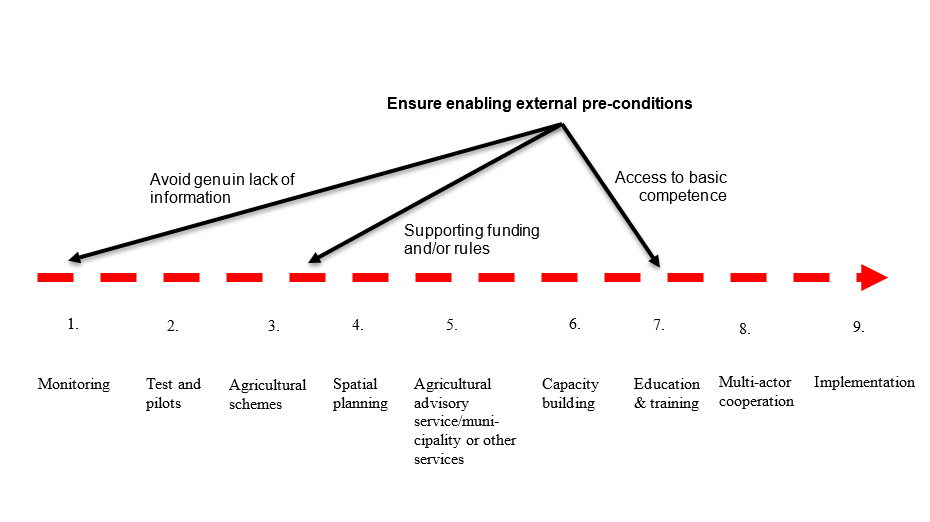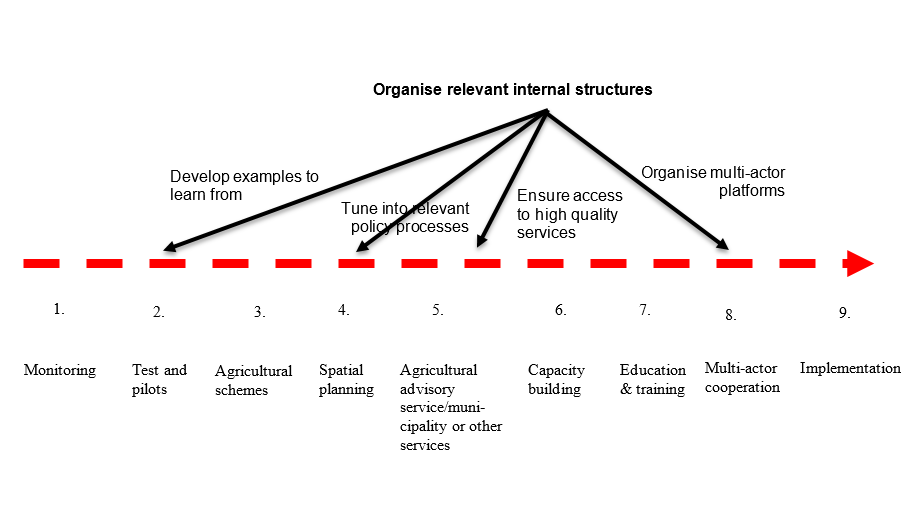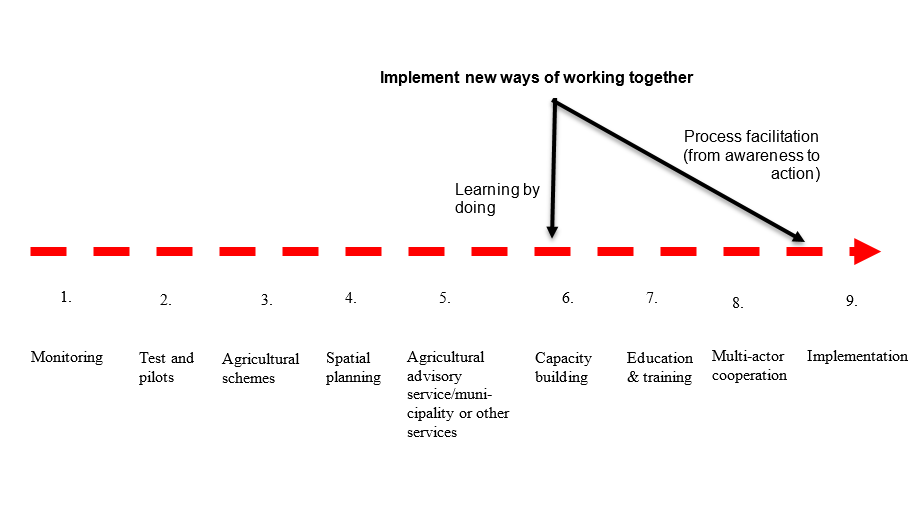Management
Integrated land and water management and rural development involves many parties, issues and activities. A model developed within the Waterdrive-project describe nine overall aspects that need to be in place (in a certain degree) if we are to achieve a sustainable development (figure 6). It is about having access to knowledge, being able to test new ideas, a conducive policy environment, for instance, schemes, planning instruments and advisory services, but also concrete activities in capacity building, education, cooperation and of course cost-effective implementation.

The abovementioned model will be the starting point for the forthcoming discussion on how leadership need to change depending of which aspects we discuss. For each part there will be specific questions that is important to ask oneself. The answers will differ, depending on context, but the questions asked will be universal. For instance, regardless situation we have to answer questions like who to involve, how to manage multiple perspectives, how to enable learning and how we can contribute to both increased capacity and trust?
Managing different phases by process design
Process design is both a way to create optimal conditions for fulfilment of certain goals, as well as to facilitate learning and decision making in groups. Many different methods and techniques have been developed to meet these ends. In different phases of a designed process different objectives or activities can be demanded. The process design should be problem-driven, not method-driven.
When working through the different phases of a designed process, different perspectives and issues will be made more salient than others will. There will always be a foreground and a background in all discussions. In addition, there will be winners and losers when implementing measures, why issues of power, equality, resource availability, etc., never should be forgotten. A thorough process design and the conscious use of participatory tools can nevertheless minimize the risk of imbalances among stakeholders and that this will create unmanageable obstacles. Being aware of these issues is always the first step, especially from a leadership perspective.
Ensure enabling external preconditions
One important dimension is to ensure as good preconditions as possible for the work. These will never be prefect when getting started, but will be crucial when doing collaboration and implementing measures. One example is the importance of monitoring, where we need to make sure that we avoid a genuine lack of information (not knowing what is true or false). Another example is having access to supporting funding schemes and a conducive regulatory framework, or access to basic competence to be able to educate or deliver training activities to specific target groups (figure 7).

Although stakeholders can agree on the need to take strong action to improve a situation, they still can be hesitant if the knowledge base is weak, additional costs for implementation is not covered, or they do not find training programs helping them to develop self-confidence and the management skills needed. Some core leadership activities in this preparatory phase is therefor to:
- Understand the collaborative potential.
- Invite stakeholders early in the process to get help in doing the analysis of the situation.
- Impact other actors so that they support the forthcoming work, creating best possible preconditions.
- Define your own role in the forthcoming process.
The collaborative potential can be assessed using the three corner stones of the progress triangle; substantial issues, procedural issues, and relational issues. If understanding the situation you, as a leader, will be able to build better preconditions. This is an activity the leader does not have to do all alone; one can invite other core stakeholders to help out with the analysis and by doing so early on starting to create engagement and a sense of involvement. Consequently, the assessment of collaborative potential might show which external actors that must be influenced, so that they might contribute in (or being prepared to) improve existing preconditions. Finally, as an initiator and leader you early must decide how you perceive your role in future work. Some questions to be asked in the assessment of a collaborative potential are structured below.
Assessment of the situation is about understanding the collaborative potential and preparing for challenges in multi-stakeholder and cross-sector processes.
- Number and nature of participants? (i.e., easiness to identify)
- History of the situation and relations? (new or long history, volatile, etc)
- What drives the current situation? (specific, identifiable interests, etc)
- Have the parties other viable solutions besides engaging in the process? (or “best alternative to negotiated agreement”)
- Are the issues clear or unclear / controversial or highly controversial?
- Is there little or considerable scientific uncertainty?
- Is relevant information for stakeholders publicly accessible and understandable?
- Are key decision maker involved and committed to collaboration?
- Are resources easily available to support collaboration or not (financial, competence, etc)?
- Level of trust and respect between actors and stakeholders?
If the situations that need collaboration but at the same time seems to have a low potential, it is usually necessary to take measures so that the preconditions improve. This is done during the preparatory phase.
Assessment of procedural issues are central to all multi-stakeholder. One reason is that collaboration is not static, it will evolve and needs to constantly adapt to new circumstances (emerging both from within and outside).
- What level of participation characterize water management in the area today (from people not being informed at all to already ongoing, local initiatives)?
- What management approaches have been used in the past (procedural history)? What can be learned from those experiences?
- Is there a need to work individually with different stakeholders before inviting to joint activities?
- What are the legal constraints and who has jurisdiction? (being clear about the framework)
- How big is the actual decision space and where lies the decision power? (potential to influence or making decisions)
- Is mutual learning desired by all stakeholders? (perceptions about being winners or losers)
- Are the resources sufficient for collaborative activities (e.g., time, money, staff)?
- Are there needs for design and facilitation by an impartial party?
- What are the procedural alternatives?
Finally, one also needs to assess the substantial issues. Collaboration aims to create substantial improvements in complex situations. But what it is that are to be improved will always be discussed by stakeholders. Some core questions are:
- What are the main issues to be managed? (this is the question we are most used to discuss and work with…)
- What are the tangible issues?
- What are the symbolic issues?
- What are the likely sources of tension over these issues (e.g., facts, culture, history, jurisdiction, values, interests, people)?
- Are issues complex? How can complexity be approached, making issues manageable?
- Is new information needed? Is it available? (involvement in knowledge creation)
- Are meanings, interpretations and understanding varied among stakeholders?
- How does different levels of understanding influence participation, decision power, etc?
- How are we to manage scientific versus local/tacit knowledge?
- How to handle situations where there is a genuine lack of information? (we do not know what is true or false, for instance regarding ecological status)
- Is there a need for training and education? Regarding what issues?
If answering or reflecting upon all these questions, you as a leader is much better prepared for the forthcoming work and take actions to create best possible preconditions when starting the joint work.
Organise relevant internal structures
Perhaps the most obvious part of leadership is to organise internal structures for the work, based on available resources. There is no format that fits all, why one must organise activities based on existing preconditions and needs. One such activity might be to establish test sites and/or pilot project which others can learn from. Another example is to analyse and tune into relevant policy processes in society that might support the ambitions in integrated land and water management. It could be related to spatial planning, but could also relate to sustainable development goals (SDG) or climate adaptation strategies. In addition, it is important to build access to high quality services, such as advisory services, if that does not exists at this point. Finally, internal organising also includes the establishment of multi-stakeholder platforms and partnerships (figure 8).

Core leadership activities includes:
- Organise (different) multi-actor platforms
- Arguing for and implementing a culture of experiential learning
- Initiate test arenas and processes to learn from
- Make sure to have support from other relevant policy processes
- Avoid lack of basic services when moving from idea to action
It is important to realise that many of these processes does not only involve one multi-stakeholder platform, it might be several but with different actors involved and managing different issues. In one geographical area you might also need to establish platforms on different scales (regional to local). When creating these platforms one start the learning process, making sure that stakeholders start learning from the experiences made early on. Another kind of platform to establish are the test arenas or pilots, as mentioned earlier. Altogether, this will support a culture of experiential learning.
Implement new ways of working together – link to the participatory toolbox
Having tried to create as good external preconditions as possible and organised to work according to the guiding principles and values, the next phase is to practice all good ideas. Of course, this is about working participatory, using the participatory toolbox, but it involves other dimensions too. Some leadership aspects to reflect upon are:
- How to build increased capacity among stakeholders by focusing on awareness, reflections, new mental models, exchange of experiences, etc?
- How to facilitate in relation to shifting needs, for instance, phases of implementation, progressing communication, group dynamics, etc?
- How to manage changing leadership role both based on how the work progress, as well as changing stakeholder needs?
- How to make sure to be a role-model for communication and learning?
- How to initiate evaluative activities to increase reflexivity (incl. meta-communication)?
As said before, these activities must not be carried out by the collaborative leadership, they can be done by an external process facilitator.

Moving from creating external preconditions to the practical work with stakeholders also reflect different phases in stakeholder involvement.
- Reaching out: Achieving initial stakeholder participation
- Reaching in (to the group): Achieving participation within a (new) group
- Reaching together: Achieving participation in content creation
- Talking about what has been achieved: Reflection, feedback and sharing results
Reaching out is linked to the external and internal pre-conditions. Reaching in is linked to internal pre-conditions established, but also implementing new ways of working together. Finally, reaching together is mainly related to the implementation activities. Reflecting upon achievement should be done continuously. Some principles for participatory work are important to reflect upon early on in the process, preferably already when starting to design the process. Try to achieve these principles:
- All relevant stakeholders are invited.
- Participants must have equal opportunities to speak out.
- Participants need to be able to speak freely.
- The multiple perspectives (including values, interests, local knowledge and needs) of stakeholders must be explored and taken into account.
- Ownership of action taken and decisions made needs to rest with participants as much as possible.
- Successful participation lead to the empowerment of the participants.
- Power imbalances among stakeholders need to be rectified as far as possible.
- The role of leaders and facilitators is mainly to support critical learning and dialogue.
- Participatory processes must be context specific and therefor flexible.
- Participatory processes must proceed on the basis of joint agreement and mutual respect.
Having the above mentioned principles in mind during the practical phases of the work, the choices made on how to work with stakeholders will be more successful.
As important as the participatory tools used during the very first meetings is the expectations you create among stakeholders. Such expectations are already created in the first invitation letter or calls you make to the stakeholders. It is therefore important to take specific notice on how to formulate yourself in order to let the stakeholders understand that the process they are supposed to encounter is different from what they are used to.
One could have a very broad definition on whom to invite. The list of stakeholder (groups) are often long and one must identify key individuals. Such stakeholder are necessary to have a dialogue with in order to successfully implement the ideas behind the collaborative work to come. As a leader you have to keep in mind that there is always alternative strategies for core stakeholders to reach their own goals rather than getting involved in multi-stakeholder partnerships. They need to be curious enough to come to the table (the first meeting) and when doing that experience the potential of new ways of working together.
Learn from experience by implementing evaluation tools
Monitoring and evaluation is the systematic data collection, analysis and reporting of activities, processes, outputs and outcomes. The reporting involves statements, judgements and conclusions on what has been done, how it has been experienced and on potential development paths and improvements. Ideally, monitoring and evaluation positively affect current and planned activities, but also future decision-making on implementation strategies.
From a leadership perspective monitoring and evaluation must be understood as a collaborative effort. Together stakeholders can track what is actually done and how well goals are achieved, demonstrate how chosen approaches have contributed to targeted gains, and better understand barriers and needs to improve future activities.
Collecting data in order to monitor and evaluate social processes often require that different tools and methods are used. No single method could fully capture the complexity. Furthermore, one must apply a flexible framework, adapted to the specific needs and preconditions in each unique context. There are tools for evaluation that will contribute to participatory work by doing evaluation in new ways. Most important, is that we monitor and evaluate continuously, collect data from many activities and actors, as well as have a dialogue within the multi-stakeholder platform on how the data should be interpreted and how the results might influence future work. An ongoing process, although with low intensity.
Within a collaborative process focusing on integrated land and water management one will have a lot of different activities to monitor and evaluate. From monitoring of environmental indicators, use of checklists, farmer workshops and training activities, implementation of new management on demo sites, external communication, and policy workshops, etc. All involving social interaction and/or learning. The evaluation methods need to suit the data needs (the desirable), but also be practical and fit within existing resources available (the feasible). Where possible the methods need to be included as a normal part of project activities – not just an add-on.
At the same time we need to be able to draw some general conclusions on success factors for implementation of measures. From an international perspective it would be of added value if one could ask similar question in different context, in order to see if there are some common answers to our challenges. Some general questions that might be raised are (examples):
- What is being done to implement new measures or influence change?
- With whom and where does these activities take place?
- What practices are changing and in which field of work?
- What impact does the new measures have on performance?
- What benefits are being achieved by the activities?
- What are the main bottlenecks in scaling up and out new measures?
- What challenges to stakeholders perceive in getting involved in organised activities?
An approach to evaluation that aim to improve ongoing work is formative evaluation. By using the evaluation toolbox this way one will contribute to an increased participation also when following up activities and monitoring progress.